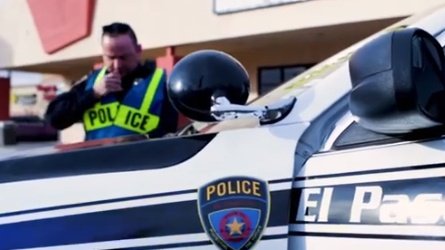School zone survival: How El Paso schools are working to prevent tragedies & keep kids safe

EL PASO, Texas -- It has been nearly five months since 7-year-old Alexa Barrera was hit and killed by a car as she walked to school at Oran Roberts Elementary in west El Paso. Her death underscores the dangers of driving in school zones and her memory still haunts many in the El Paso Independent School District.
“That weighs on me every day,” said EPISD police officer Jesse Dorantes. “It’s not something that I forget.”
As an EPISD police officer, Dorantes does not take his job lightly.
“As you know, we’ve had three fatalities on the West Side in the last two years,” Officer Dorantes said.
Those fatalities include Barrera, as well as a mother who was hit and killed in the Tippin Elementary parking lot, and a 13-year-old girl hit by a car while walking home from Lincoln Middle School.
“The West Side is insane with traffic,” Officer Dorantes said. “I’m supposed to work eight hours. I work 10-hour days now because of the traffic.”
Officer Dorantes works to bring a reassuring presence to the campuses he patrols. We joined him at Polk Elementary, where some parents said they fear distracted drivers and distracted parents.
“The kids are smaller. They don't pay a lot of attention,” said Maria Rodrigeuz, a Polk Elementary parent. “Sometimes they're just goofing around and then the parents are on the phone or watching the other kids. They don't pay attention.”
Others said drivers don’t take the school zone seriously.
“Just a few days ago I was walking with my 5-year-old and we were halfway through the crosswalk and a car kept approaching us and I thought I was going to have to smack the car before she finally stopped,” said Marina Pedraza, a parent at Polk Elementary. “At the time there was no crossing guard here. It'd be nice if we had more people out here helping make sure that the cars are paying attention.”
“We pitched to the city to make this a full-way stop,” said Officer Dorantes in response. “They’ve done studies and they say the amount of traffic during the day doesn’t warrant it, but two times a day it’s really bad.
Officer Dorantes said the most common offenses he sees while patrolling are speeding and passing other cars, which is against the law in school zones throughout Texas.
“The reason being is if a kid is going to dart out in traffic or even stop and you pass, the likelihood of you hitting him is going to be a lot more,” said Officer Dorantes.
As an EPISD police officer, he is able to enforce safe driving by issuing citations. Dorantes said he writes roughly five tickets a day and 25 total each week.
“We’re not looking to create revenue,” he said. “We’re looking for compliance. A lot of people think that we have quotas to meet, but in all honesty, I don’t want to be in court all day instead of my campus.”
As an officer, Officer Dorantes said he often helps with several campuses beyond those he’s assigned to patrol.
“It’s very hard. I hate having to select which one I’m going to be at, but that’s the choices we make,” he said.
EPISD officials said each high school and middle school in the district is assigned an officer, and those officers patrol elementary schools as well. There are 44 officers in the district and EPISD has 89 campuses. Traffic is not their only job.
When it comes to certified crossing guards, Officer Dorantes said it is possible not every campus will have one every day. It is up to the campus to fill those spots through paid workers or volunteers.
To become a certified crossing guard volunteer for the district, you must be at least 18 years old. If you are interested in volunteering, EPISD recommends you contact the principal or assistant principal at the school you’re interested in volunteering for, who can help you achieve the certification necessary.
Outside of EPISD, and all across the Borderland, reckless drivers scare parents.
“Sometimes they’ll just speed up. They don’t see the 15 miles per hour,” said one local parent.
At the Ysleta Independent School District, Chief of Security J.R. Martinez says misuse of technology is making things worse.
“You often see people on their cell phones or stopping in the middle of the road to take a picture," he explained.
YISD does not have its own police department, so safety officers do not have the authority to write tickets to drivers who break the law.
“The only recourse pretty much that we have is to report them,” said Officer Martinez. “But we work very closely with the El Paso (Police) Department.”
Officer Martinez said many that drive school zones live within the area.
“If you missed them one day,” he said, “they’re probably going to be there the next day.”
Officer Martinez said the decision to not have a police department was “above (his) pay grade,” but said the work that the district’s 87 officers do matches his expectation of security and safety. “Our department is not small by virtue of manpower,” he added.
YISD officials said that an in-house police department is cost prohibitive, and the decision to have a security department was made more than 20 years ago.
the Socorro Independent School District has its own police department. For SISD police officer Mike Baranyay, it makes a big difference.
“We can just allocate the resources because we have them, and obviously that comes at a financial cost, but the benefit obviously is you have control over your own police department,” Officer Baranyay said. “It alleviates the burden on the city police or county sheriff.”
Still, regardless of enforcement styles, no district is free from dangerous drivers. We joined Officer Baranyay on patrol in an unmarked unit, where we witnessed illegal u-turns and speeding.
Socorro district records show speeding was by far the most common violation SISD officers reported last year. Those records show they stopped 290 drivers. SISD officers stopped 98 drivers for violating stop signs, 64 drivers for expired registration, 60 drivers for disregarding crossing guards and 53 drivers for passing. 23 drivers were stopped for making illegal U-turns in school zones.
The problems in school zones are not just due to drivers oblivious to those zones. SISD officer Eddie Tarin says parents often drop off their children outside designated drop-off zones. He also says he frequently says he sees students disregarding crosswalks and dangers in the roads.
One of the biggest concerns for El Paso Police Department is distracted driving.
“That's a place where you don't want to be distracted,” said Sgt. Robert Gomez, a spokesperson for EPPD. “Taking your eyes off the road for just a quick second can really be catastrophic because, you know, sometimes children run into the street.”
Police representatives say even the smallest distractions can have a big impact.
“There's so much going on in a school zone,” said EPPD Officer Adrian Cisneros. “You have pedestrians crossing the street. You have parents that are trying to get in and out quickly because they have to go to work.”
We worked alongside Officer Cisneros and Sgt. Gomez to demonstrate that impact. We found that a driver traveling 30 miles per hour traveled nearly 200 feet, after looking down for two seconds and applying the brakes. That’s the length of about five school buses.
“Two seconds is enough to start a text, open your phone, change the station, read a text. A lot of time we'll get people involved in crashes and they'll say I only looked down for two seconds,” said Sgt. Gomez.
As speed increases, so does the risk.
“Typically, vehicles travel a lot faster than the 30 mile per hour limit in residential areas,” Officer Cisneros said. “The faster you go, the less time you have to react.”
Dr. Anita Bialunska, a professor in UTEP’s rehabilitation sciences department, explained that reaction time is influenced by many different factors, including ones that may seem less obvious.
“There are the complicated factors,” Dr. Bialunska said, “(such as) how aware we are in this particular moment when we are driving with our attention, you know, memory, working memory, how overwhelmed we are and what (we are) thinking about.”
Dr. Bialunska said it’s just as important to think about how we’re reacting, not just how fast.
“Sometimes it’s better even to avoid reacting than actually react,” said. “Sometimes we can react very fast but the reaction is not the best in this particular context.”
Dr. Bialunska said the best tips for improving responses while driving come from taking care of your health, physically and mentally. Plus, she said it’s important to implement change.
“When you’re an experienced driver, try from time to time to take a different route,” she said. “Not the same way. You may think it’s safe because you know the way. Everything should be more predictable. But it makes you less attentive to what’s going on.”
The thing we can control while driving is any distraction we allow to take our eyes off the road.
“It doesn't matter what speed you're traveling at. When you're distracted, you've traveled a distance that you can't take back,” said Officer Cisneros. “It just takes a second from something wrong to happen.”




